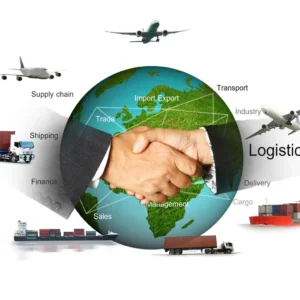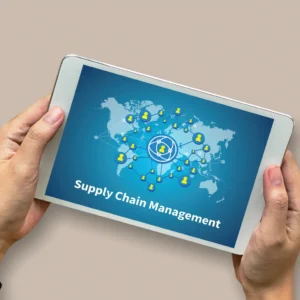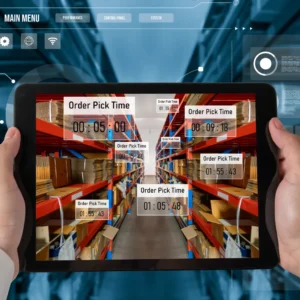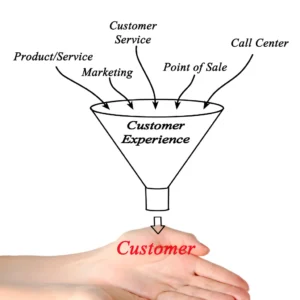
Revolutionizing Logistics
AI Tools for Operational Efficiency and Automation in the Transport and Supply Chain Landscape.
Integrating cutting-edge technologies has become critical in today’s rapidly evolving logistics industry. AI tools for operational efficiency and automation in the logistics industry offer a transformative solution to address the sector’s dynamic challenges.
Leveraging AI, these tools aim to revolutionize critical aspects like predictive maintenance, route optimization, automated document management, and workforce coordination.
As organizations strive to streamline processes, reduce errors, and enhance overall supply chain performance, deploying such advanced tools becomes a strategic imperative.
This discussion delves into the intricacies of developing and implementing AI-driven solutions, emphasizing their potential to elevate logistics operations’ efficiency, accuracy, and competitiveness on a global scale.
Table of Contents

Arindam Roy
An Automation Consultant with 25+ years of IT Experience
5 AI Tool ideas for Operational Efficiency and Automation
Developing AI tools for Operational Efficiency and Automation in the Transportation and Logistics industry can significantly enhance operational efficiency and streamline various processes. Here’s an elaboration on the selected tools:
AI-Powered Workforce Management:
- Automated Scheduling: Use AI algorithms to create optimized schedules for drivers, warehouse staff, and other personnel based on historical data, traffic patterns, and real-time demand.
- Predictive Maintenance: Implement predictive maintenance models to schedule maintenance tasks proactively, reducing unplanned downtime for vehicles and equipment.
Automated Document Management:
- Document Digitization: Utilize OCR technology to convert paper documents into digital formats, making information management more accessible.
- Intelligent Indexing: Develop AI algorithms to categorize and index documents automatically, making searching and accessing relevant information faster.
Invoice and Billing Automation:
- Automated Invoice Processing: Implement AI-based systems to extract information from invoices, verify the accuracy, and automate the billing process, reducing errors and accelerating payment cycles.
- Dynamic Pricing: Utilize AI to optimize pricing strategies based on demand, supply chain conditions, and market trends.
AI-Enhanced Equipment Utilization:
- Predictive Maintenance for Vehicles: Use machine learning algorithms to predict when a vehicle or equipment will fail, optimizing maintenance schedules and minimizing downtime.
- Route Optimization: Implement AI-powered route planning algorithms to optimize delivery routes, considering real-time traffic conditions, weather, and other factors.
Predictive Warehouse Space Management:
- Inventory Forecasting: Employ AI models to predict demand for different products, optimizing warehouse space by ensuring that popular items are readily available while minimizing excess stock.
- Dynamic Warehouse Layouts: Implement systems that can dynamically adjust the warehouse layout based on incoming orders and inventory levels to maximize efficiency.
Collectively, these tools contribute to operational efficiency by automating repetitive tasks, optimizing resource allocation, and providing valuable insights through data analytics. Additionally, they help reduce costs, enhance accuracy, and improve overall decision-making in the transportation and logistics domain.
AI-Powered Workforce Management Tool
Business Knowledge Requirements:
- Logistics Operations Understanding: In-depth knowledge of logistics operations, including understanding vehicle types, loading/unloading processes, and compliance requirements for drivers and warehouse staff.
- Labour Regulations Knowledge: Understanding labour laws, union agreements, and work hour restrictions to ensure compliance with workforce scheduling.
- Predictive Maintenance Know-How: Familiarity with vehicle and equipment maintenance requirements, including factors leading to breakdowns and optimal maintenance schedules.
Software Requirements:
- AI Scheduling Algorithms: Development of AI algorithms capable of creating optimized schedules considering historical data, traffic patterns, and real-time demand.
- Predictive Maintenance Models: Implementing machine learning models for predictive maintenance, analyzing historical performance data and equipment specifications.
- User Interface (UI) Design: Development of an intuitive and user-friendly interface for logistics managers to interact with the AI-powered system.
Hardware Requirements:
- Scalable Computing Resources: Adequate computing power for running complex optimization algorithms for scheduling and predictive maintenance.
- Telematics Integration: Integration with telematics systems on vehicles and equipment to gather real-time data for predictive maintenance models.
Integration Requirements to Existing Toolset:
- ERP and SCM Integration: Seamless integration between ERP and SCM systems is critical for effective workforce management.
- Telematics Integration: Integration with telematics systems for real-time tracking of vehicles and monitoring their performance, aiding in schedule optimization.
Training Required for Existing Staff to Run the Tool:
- Algorithm Understanding: Training for logistics managers to understand the AI algorithms used for scheduling and predictive maintenance, empowering them to make informed decisions.
- User Interface Interaction Training: Familiarize yourself with the UI and interact with the AI-powered system to ensure effective utilization.
Challenges and Workarounds in Implementing the Tool:
- Resistance to Change:
- Challenge: Existing staff may need help adopting AI-based scheduling and maintenance practices.
- Workaround: Conduct comprehensive training programs, highlight the benefits, and involve staff in the transition process to address concerns.
- Data Security Concerns:
- Challenge: Concerns about the security of data collected from telematics systems.
- Workaround: Implement robust cybersecurity measures, comply with data protection regulations, and transparently communicate security protocols.
Similar Tools Already Available in the Market:
- Llamasoft: This company offers AI-powered solutions for supply chain management, including efficient workforce management tools.
Cost and Benefit Analysis:
- Costs:
- Development costs, including software and hardware investments.
- Integration expenses with existing systems.
- Training expenses for staff.
- Ongoing maintenance and support costs.
- Benefits:
- Enhanced operational efficiency through optimized schedules.
- Proactive maintenance leads to reduced unplanned downtime.
- Improved resource utilization and productivity.
Recommendation: Integrate with Similar Available Products:
Considering the specialized nature of AI tools for Operational Efficiency and Automation in transportation and logistics, integrating with existing solutions like Optergon or Llamasoft is recommended.
Automated Document Management Tool
Business Knowledge Requirements:
- Logistics Documentation Understanding: In-depth knowledge of logistics documents, including shipping manifests, customs declarations, invoices, and receipts, to design effective document management workflows.
- Compliance Knowledge: Awareness of industry regulations and compliance standards related to document retention and data security in logistics.
- Workflow Optimization: Understanding logistics workflows to seamlessly integrate the document management tool, ensuring it aligns with existing processes.
Software Requirements:
- OCR Technology: Implementation of Optical Character Recognition (OCR) technology for accurately converting paper documents into digital formats.
- Intelligent Indexing Algorithms: Development of AI algorithms for intelligent document indexing, ensuring efficient categorization and retrieval of information.
- Data Encryption and Security Features: Integration of robust security measures to safeguard sensitive logistics data stored digitally.
Hardware Requirements:
- Scalable Storage Solutions: Deploy scalable and secure data storage systems to accommodate the growing volume of digitized documents.
- High-Performance Servers: Utilization of high-performance servers for OCR processing and AI algorithms, especially during peak document processing times.
Integration Requirements to Existing Toolset:
- ERP and SCM Integration:
- Integration of document management with ERP and SCM systems streamlines logistics operations.
- Customs Software Integration:
- Integration with customs-related software to ensure accurate and efficient handling of customs documentation.
Training Required for Existing Staff to Run the Tool:
- System Familiarization:
- Training sessions to familiarize staff with the automated document management system, emphasizing its benefits and how it integrates into their daily tasks.
- Indexing and Retrieval Training:
- Specific training on using the intelligent indexing system for efficient categorization and retrieval of documents.
Challenges and Workarounds in Implementing the Tool:
- Data Quality Challenges:
- Challenge: Ensuring the accuracy of OCR technology, especially when dealing with documents in varying formats and qualities.
- Workaround: Implement rigorous data validation checks and manual verification processes for critical documents.
- Integration Complexity:
- Challenge: Integrating the tool with existing systems might be complex due to different data structures and formats.
- Workaround: Use middleware solutions or APIs to bridge the gap between the document management tool and existing software.
Similar Tools Already Available in the Market:
- M-Files: Offers intelligent document management with workflow automation features.
- Box: Provides cloud-based document management solutions with collaboration features.
Cost and Benefit Analysis:
- Costs:
- Development costs, including software and hardware investments.
- Integration expenses with existing systems.
- Training expenses for staff.
- Ongoing maintenance and support costs.
- Benefits:
- Improved document accessibility and retrieval speed.
- Improved data security measures and adherence to industry regulations for compliance.
- Streamlined workflows leading to increased operational efficiency.
Recommendation: Integrate with Similar Available Products:
Considering the specialized nature of AI tools for Operational Efficiency and Automation in transportation and logistics, integrating with existing document management solutions like M-Files or Box is recommended.
Invoice and Billing Automation Tool
Business Knowledge Requirements:
- Billing and Invoicing Processes: In-depth understanding of the end-to-end billing and invoicing processes in the logistics industry, including various charges, taxes, and regulatory requirements.
- Supply Chain Dynamics: Knowledge of supply chain conditions and market trends to align dynamic pricing strategies with the current industry landscape.
- Compliance Knowledge: Awareness of legal and regulatory frameworks related to invoicing and billing in the logistics sector.
Software Requirements:
- AI-based Invoice Processing System: Development of AI algorithms for automated extraction of information from invoices, ensuring accuracy in billing and reducing errors.
- Dynamic Pricing Algorithm: Implementing AI-driven dynamic pricing algorithms considering demand fluctuations, supply chain conditions, and market trends.
- Data Analytics and Reporting Tools: Improved financial insights by integrating data analytics and reporting tools to analyze billing patterns, pricing effectiveness, and overall performance.
Hardware Requirements:
- Scalable Computing Resources: Adequate computing power for running complex AI algorithms for automated invoice processing and dynamic pricing optimization.
- Secure Data Storage: Implement secure and scalable data storage solutions for pricing strategies to store billing information and historical data.
Integration Requirements to Existing Toolset:
- ERP and Billing System Integration: Seamless integration with Enterprise Resource Planning (ERP) and existing billing systems ensures a cohesive workflow and data consistency.
- Data Analytics Integration: Integration with data analytics platforms for comprehensive reporting and analysis of billing and pricing data.
Training Required for Existing Staff to Run the Tool:
- AI System Familiarization: Training sessions to familiarize billing and finance staff with the AI-based automated invoice processing system, emphasizing its benefits in reducing errors and accelerating payment cycles.
- Dynamic Pricing Training: Training on understanding and interpreting dynamic pricing strategies, ensuring staff can adjust to market trends and optimize pricing accordingly.
Challenges and Workarounds in Implementing the Tool:
- Data Accuracy Challenges:
- Challenge: Ensuring the accuracy of extracted information from invoices.
- Workaround: Implement data validation checks, periodic audits, and manual verification processes for critical data points.
- Integration Complexity:
- Challenge: Integrating with existing ERP and billing systems might be complex.
- Workaround: Utilize middleware solutions, APIs, or connectors to facilitate smoother integration.
Similar Tools Already Available in the Market:
- Bill.com: Offers automated invoicing and billing solutions for businesses.
- Apttus Revenue Management: Provides revenue management solutions with dynamic pricing capabilities.
Cost and Benefit Analysis:
- Costs:
- Development costs, including software and hardware investments.
- Integration expenses with existing systems.
- Training expenses for staff.
- Ongoing maintenance and support costs.
- Benefits:
- Reduced errors in billing processes.
- Accelerating payment cycles can lead to improved cash flow.
- Optimized pricing for increased competitiveness.
Recommendation: Integrate with Similar Available Products:
Considering the specialized nature of AI tools for Operational Efficiency and Automation in transportation and logistics, integrating with existing solutions like Bill.com or Apttus Revenue Management is recommended.
AI-Enhanced Equipment Utilization Tool
Business Knowledge Requirements:
- Vehicle and Equipment Understanding: In-depth knowledge of various vehicles and equipment used in logistics, including their specifications, maintenance requirements, and performance metrics.
- Supply Chain Dynamics: Understanding the dynamics of supply chain operations to optimize equipment utilization within the broader context of logistics processes.
- Maintenance Best Practices: Familiarity with maintenance best practices to develop practical predictive maintenance algorithms for vehicles and equipment.
Software Requirements:
- Predictive Maintenance Algorithms: Development of machine learning algorithms for predictive maintenance, analyzing historical performance data to predict failures and optimize maintenance schedules.
- Route Optimization Algorithms: Implementing AI-powered route planning algorithms considering real-time traffic conditions, weather, and other factors to optimize delivery routes.
- User Interface (UI) for Visualization: Creating an intuitive UI to visualize predictive maintenance insights and route optimization suggestions for logistics managers.
Hardware Requirements:
- Scalable Computing Resources: Adequate computing power for running complex machine learning algorithms for predictive maintenance and route optimization.
- Telematics Systems: Integration with telematics systems on vehicles and equipment to gather real-time data for predictive maintenance and route optimization.
Integration Requirements to Existing Toolset:
- ERP and SCM Integration: Access relevant data for equipment utilization through seamless integration with Enterprise Resource Planning (ERP) and Supply Chain Management (SCM) systems.
- Telematics Integration: Integration with telematics systems for real-time tracking of vehicles and monitoring their performance, aiding in route optimization.
Training Required for Existing Staff to Run the Tool:
- Algorithm Understanding: Training sessions to ensure logistics managers understand the predictive maintenance and route optimization algorithms, enabling them to make informed decisions.
- UI Interaction Training: Familiarization with the UI for effective interaction with the AI-enhanced equipment utilization tool.
Challenges and Workarounds in Implementing the Tool:
- Data Quality Challenges:
- Challenge: Ensuring the quality and accuracy of data used for predictive maintenance and route optimization.
- Workaround: Implement data validation processes, conduct regular data audits, and invest in telematics systems for accurate real-time data.
- Algorithm Fine-Tuning:
- Challenge: Fine-tuning predictive maintenance and route optimization algorithms for optimal accuracy.
- Workaround: Regularly assess algorithm performance, incorporate feedback, and adapt to changing logistics and traffic conditions.
Similar Tools Already Available in the Market:
- Trimble Transportation: Offers solutions for route optimization and fleet management.
- Geotab: Provides telematics solutions for vehicle tracking and maintenance optimization.
Cost and Benefit Analysis:
- Costs:
- Development costs, including software and hardware investments.
- Integration expenses with existing systems.
- Training expenses for staff.
- Ongoing maintenance and support costs.
- Benefits:
- Reduced downtime through predictive maintenance.
- Optimized routes leading to fuel and time savings.
- Improved overall equipment utilization and supply chain efficiency.
Recommendation: Integrate with Similar Available Products:
Considering the specialized nature of AI tools for Operational Efficiency and Automation in transportation and logistics, integrating with existing solutions like Trimble Transportation or Geotab is recommended.
Predictive Warehouse Space Management Tool
Business Knowledge Requirements:
- Inventory Management Understanding: In-depth knowledge of inventory management processes, including SKU characteristics, turnover rates, and storage requirements.
- Supply Chain Dynamics: Understanding supply chain dynamics to align warehouse space management with overall logistics operations.
- Data Analysis Skills: Proficiency in data analysis to interpret AI-generated forecasts and dynamically adjust warehouse layouts.
Software Requirements:
- AI-based Inventory Forecasting Models: Development of AI models for accurate inventory forecasting, predicting demand for different products based on historical data and external factors.
- Dynamic Layout Optimization Algorithms: Implement algorithms that dynamically adjust the warehouse layout based on real-time order volumes, inventory levels, and demand patterns.
- User Interface (UI) for Visualization: Creating an intuitive UI to visualize inventory forecasts, warehouse layouts, and suggested adjustments for warehouse managers.
Hardware Requirements:
- Scalable Computing Resources: Adequate computing power for running complex AI models for inventory forecasting and dynamic layout optimization.
- Real-time Data Processing Systems: Integration with real-time data processing systems ensures the tool receives and analyzes the most up-to-date information.
Integration Requirements to Existing Toolset:
- ERP and WMS Integration: Seamless integration with Enterprise Resource Planning (ERP) and Warehouse Management Systems (WMS) to access relevant data for warehouse space management.
- Real-time Data Integration: Integration with real-time data sources, including order processing systems, ensures the tool receives the latest information for accurate predictions.
Training Required for Existing Staff to Run the Tool:
- AI Model Interpretation: Training sessions to ensure warehouse managers understand and interpret the predictions generated by AI-based inventory forecasting models.
- UI Interaction Training: Familiarization with the UI for effective interaction with the tool, including adjusting warehouse layouts based on AI recommendations.
Challenges and Workarounds in Implementing the Tool:
- Data Quality Challenges:
- Challenge: Ensuring the quality and accuracy of data used for inventory forecasting.
- Workaround: Implement data cleaning processes, regularly update databases, and use feedback loops for continuous improvement.
- Resistance to Dynamic Layouts:
- Challenge: Warehouse staff may resist frequent changes to the layout.
- Workaround: Communicate the benefits of dynamic layouts regarding efficiency and space utilization and involve staff in decision-making.
Similar Tools already available in the market:
- Blue Yonder (formerly JDA Software): Provides AI-driven solutions for inventory forecasting and warehouse optimization.
- HighJump Warehouse Advantage (now Korber): Offers warehouse management solutions with AI capabilities for space optimization.
Cost and Benefit Analysis:
- Costs:
- Development costs, including software and hardware investments.
- Integration expenses with existing systems.
- Training expenses for staff.
- Ongoing maintenance and support costs.
- Benefits:
- Optimized warehouse space utilization.
- Reduced holding costs and excess stock.
- Improved order fulfilment efficiency.
Recommendation: Integrate with Similar Available Products:
Considering the specialized nature of AI tools for Operational Efficiency and Automation in transportation and logistics, integrating with existing solutions like Blue Yonder or HighJump Warehouse Advantage is recommended.
Conclusion on AI tools for Operational Efficiency and Automation in transportation and logistics
In conclusion, developing AI tools for operational efficiency and automation in the logistics industry presents a transformative opportunity for organizations to enhance their competitive edge.
The chosen tools, spanning predictive maintenance, route optimization, automated document management, invoice and billing automation, AI-powered workforce management, and predictive warehouse space management, collectively address key pain points in the industry. These tools can significantly streamline processes, reduce errors, and optimize resource utilization by leveraging advanced technologies such as machine learning and AI algorithms.
To navigate the complexity of the transportation and logistics landscape successfully, an organization specializing in this domain should prioritize a deep understanding of logistics operations, compliance requirements, and supply chain dynamics. Integrating these AI tools with existing systems, such as ERP, SCM, and telematics, ensures a cohesive and efficient workflow.
Considering the wealth of available solutions in the market, the recommendation is to strategically integrate with proven, industry-specific tools rather than building from scratch. This approach aligns with the organization’s identity as an AI pioneer, offering quicker deployment, cost-effectiveness, and scalability.
In adopting these AI tools, the logistics industry stands to gain operational efficiencies and cost savings and improved customer satisfaction through optimized services, timely deliveries, and enhanced overall supply chain visibility. Embracing these technologies positions organizations at the forefront of innovation, poised for sustained growth and success in the ever-evolving transportation and logistics landscape.
Related Articles
- AI Tools for Predictive Analytics and Business Intelligence
- AI Tools for Sustainability and Green Logistics
- AI Tools for Compliance and Regulatory Support
- AI Tools for Fleet Maintenance and Monitoring
- AI Tools for Supply Chain Visibility and Collaboration
- AI Tools for Order and Shipment Tracking
- AI Tools for Warehouse Management and Automation
- AI Tools for Route Optimization and Planning
- AI Tools for Risk Management and Security
- AI tools in the Transportation and Logistics industry




























